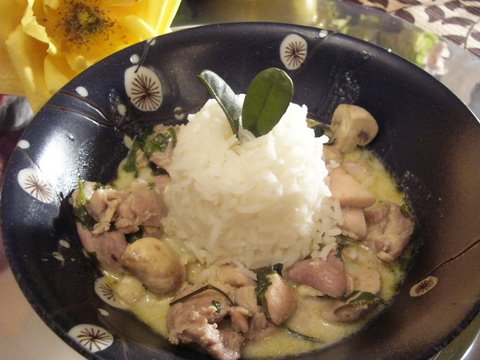Where do curry colors get their names? It all depends on the ingredients used to make the curry paste. Green Curry (pictured here) uses fresh cilantro, lime leaves, and chilies that give it a green hugh. Yellow Curry uses, among other things, lemon grass, shallots, and ginger resulting in a yellow tone. Red Curry, perhaps the firiest of them all, uses red chilis and garlic.
Green goes well with chicken or shrimp. Yellow pairs well with vegetables and fish, while red compliments the stronger flavor of beef or pork.

Tender chicken and mushrooms surround an island of Jasmine Rice
Basic technique is to heat a bit of coconut milk over medium heat until is begins to bubble and release its fragrance. Then stir in a spoonful of curry paste and fry for a few more minutes before adding the primary ingredients of your dish. Continue to cook until the chicken or beef takes on some color, then add in coconut milk and other seasonings you are going to use. Fish Sauce, know as Nam Pla, is key to an authentic Thai taste.
Full recipes for Green Curry can be found in the Thai ebooks on the products page. The books feature an entire menu of dishes that complement each other so you save time searching the web to round out your meal. There is also a time management sheet to help you put the meal together easily in the quickest manner possible.
Now that you read this far, I will give you a secret tip. Thai Curries often call for fresh Thai basil which has a licorice overtone to it. When only regular basil is available, add a pinch of anise seed to the curry pot to mimic the addictive flavor of Thai basil. Be sure to top it all of with freshly ground peanuts (dry roasted, unsalted) like the Thai do!
 Mediterranean Diet Recipes
Mediterranean Diet Recipes Categories:
Categories:  Tags:
Tags:
Great post. I’ve known this but you make it sound so interesting and now all I can think about is making some curry. Thanks!